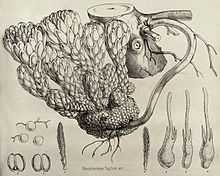Dactylanthus taylorii
| Dactylanthus taylorii | |
|---|---|
 | |
| Conservation status | |
| Scientific classification | |
| Kingdom: | Plantae |
| (unranked): | Angiosperms |
| (unranked): | Eudicots |
| (unranked): | Core eudicots |
| Order: | Santalales |
| Family: | Balanophoraceae |
| Genus: | Dactylanthus Hook.f. |
| Species: | D. taylorii |
| Binomial name | |
| Dactylanthus taylorii Hook.f. | |
Dactylanthus taylorii, commonly known as wood rose or Hades flower,[2][3] is a fully parasitic plant that grows on the roots of certain trees in New Zealand. The host tree responds to the presence of Dactylanthus by forming a burl-like structure that resembles a fluted wooden rose (hence the common name). Māori names for wood rose are pua o te reinga or pua reinga ("flower of the underworld")[4] and waewae atua, "feet of gods". It is monotypic to the Dactylanthus genus. One of its most common host trees is pate or seven-finger (Schefflera digitata).
Description
Plants are either male or female. They flower between January and April and are primarily pollinated by the native New Zealand Lesser Short-tailed Bat.[5] The nectar exudes a musky smell that resembles mammalian sweat.[6][7] Introduced mice and rats also pollinate them although rats tend to destroy them. Fruits about 2 millimetres (0.079 in) long are produced from February to May. The plant has no green leaves, and roots are also absent, the plant being connected to the host by its stem. Some plants have been aged in excess of 30 years old. It prefers damp but not waterlogged soil, and is often found at the head of small streams. It tends to live under dense canopies of tall trees but some specimens may be found at forest borders.
The plant is cryptic, and hence hard to survey, but there are unlikely to be more than a few thousand in existence. Most of these are in the North Island, including Northland, Coromandel Peninsula, East Coast and central regions, but there are a few on Little Barrier Island. It is likely that many sites are known only to collectors, as the woody growth has commercial value.
Conservation status
Dactylanthus is regarded, as of 2004, as a 'Category A' threatened species. The New Zealand Department of Conservation started a recovery plan in 1995. Protection measures include pest control and enclosure of the plants in cages.
The wood rose is under threat from harvesting by collectors, browsing by possums, rats, pigs and deer, habitat loss, and the rarity of its pollinators and seed dispersers.
References
- ↑ "Dactylanthus taylorii". New Zealand Plant Conservation Network. Retrieved 25 September 2012.
- ↑ "Science & Nature - Wildfacts - New Zealand short-tailed bat". BBC. 2008-07-25. Retrieved 2011-10-20.
- ↑ "NZJEcol20_1_81.pdf" (PDF). Retrieved 2011-10-23.
- ↑ "Facts: Dactylanthus: Native Plants: Conservation". Doc.govt.nz. 2006-09-01. Retrieved 2011-10-20.
- ↑ "Location of Short-Tailed Bats using Dactylanthus" (PDF). Retrieved 2011-10-20.
- ↑ "The use of Dactylanthus nectar as a lure for possums and bats" (PDF). Retrieved 2011-10-23.
- ↑ "The most terrestrial of bats : Tetrapod Zoology". Scienceblogs.com. Retrieved 2011-10-29.
External links
- Department of Conservation - wood rose information.
